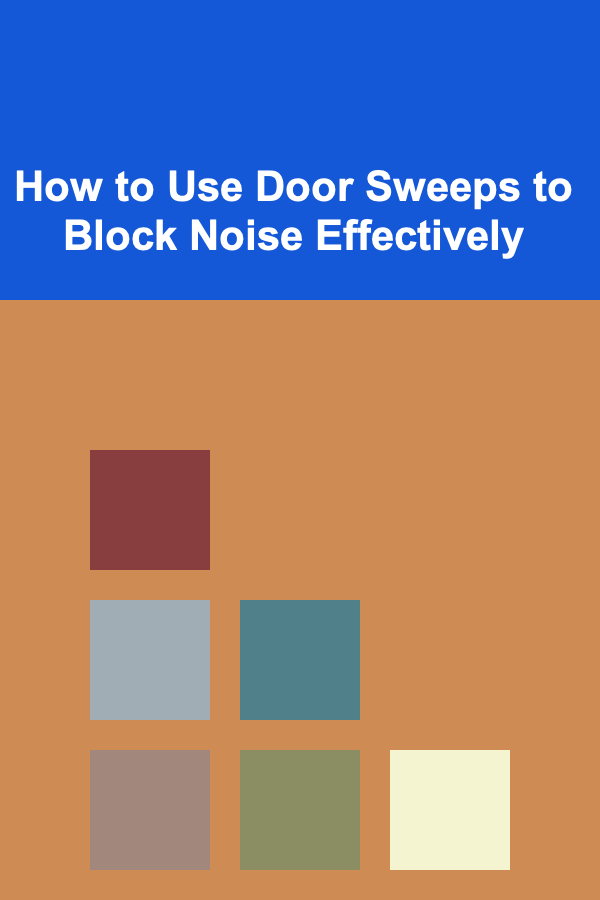
How to Use Door Sweeps to Block Noise Effectively
ebook include PDF & Audio bundle (Micro Guide)
$12.99$5.99
Limited Time Offer! Order within the next:

Noise pollution is one of the most common and irritating challenges people face in residential and commercial spaces. It disrupts daily life, affects concentration, and even impacts mental and physical well-being. While there are various methods to manage and reduce noise, one of the most effective and cost-efficient strategies is using door sweeps. These unassuming tools can significantly reduce the amount of sound that enters or leaves a room, providing a quieter, more peaceful environment.
In this article, we'll delve into the science of noise transmission, explain how door sweeps work to block noise, and provide practical tips on choosing and installing door sweeps for maximum effectiveness.
Understanding How Noise Travels
Before diving into how door sweeps can help with noise reduction, it's important to understand how sound travels through different materials. Sound is a vibration that propagates through air, water, and solid materials. When it comes to buildings, sound can travel through walls, ceilings, floors, windows, and even the gaps beneath doors.
Types of Noise
There are several types of noise that door sweeps can help mitigate:
- Airborne Noise: This type of noise is carried by the air and is typically high-frequency sounds, such as speech, music, or television noise. Airborne sounds are the most common type of noise that door sweeps are designed to block.
- Impact Noise: Impact noise occurs when objects physically hit a surface, such as footsteps, dropped items, or furniture being moved. This type of noise can be difficult to block because it involves low-frequency sound vibrations, but door sweeps can still help prevent some of these vibrations from traveling under doors.
- Flanking Noise: This occurs when sound bypasses the primary barrier (such as a wall) by traveling through other structures like gaps around doors, windows, or electrical outlets. Door sweeps can help minimize flanking noise, especially when installed properly.
Why the Space Under the Door Matters
The gap between the door and the floor is often one of the most significant sources of unwanted noise in a room. Even if the door itself is solid and insulated, sound can easily slip through this space, disrupting peace and privacy. By installing a door sweep, you can block this gap and reduce the noise that travels between rooms, hallways, or from outside.
What Is a Door Sweep?
A door sweep is a device installed at the bottom of a door to seal the gap between the door and the floor. It's a simple yet highly effective tool for preventing noise, dust, drafts, and even pests from entering or leaving a room. Door sweeps come in various styles and materials, each with its own benefits for noise reduction.
Components of a Door Sweep
- Seal: The seal is the material that makes contact with the floor. It's typically made of rubber, silicone, vinyl, or a combination of these materials. The seal creates a tight barrier that prevents air and sound from passing through the gap.
- Backing Plate: The backing plate is a rigid piece that attaches to the bottom of the door. This component provides support for the seal and ensures that it remains in place. The backing plate is typically made of metal or plastic and is fastened to the door using screws or adhesive.
- Adjustable Mechanism: Some door sweeps feature an adjustable mechanism, allowing you to modify the height of the seal depending on the thickness of the gap beneath the door. This is especially useful for doors with uneven floors or for those who need to fine-tune the seal to achieve maximum noise reduction.
How Do Door Sweeps Block Noise?
The primary purpose of a door sweep is to seal the gap between the door and the floor. However, the materials used and the way the sweep works are also critical factors in how effective it is at blocking noise.
Soundproofing with Mass
One of the key principles in soundproofing is the concept of mass. Sound waves are easier to transmit through lightweight materials, so heavier materials are more effective at blocking noise. Door sweeps made from dense, flexible materials like rubber or silicone are particularly effective at blocking airborne noise because they create a solid barrier that sound waves cannot easily penetrate.
Additionally, the shape and design of the door sweep are important. Some door sweeps have a brush-like design, while others feature a more solid, rubberized seal. The solid seals are better at blocking sound, as they don't allow air or sound to pass through any gaps.
Creating a Tight Seal
The effectiveness of a door sweep also depends on how well it creates a tight seal against the floor. A poorly fitted door sweep may still allow sound to slip through the gaps. Therefore, it's crucial to install the sweep in such a way that it conforms to the floor and creates an airtight, soundproof barrier.
Adjustable door sweeps are particularly useful in this regard, as they allow you to make minor adjustments for a better seal. The tighter the seal, the more effective the door sweep will be at blocking noise.
Reducing Airborne and Impact Noise
Door sweeps primarily block airborne noise, such as voices, music, or television sounds. However, they can also help reduce the impact of noise caused by footsteps or furniture movement. Although a door sweep may not completely eliminate impact noise, it can help mitigate it by preventing vibrations from traveling through the gap under the door.
Types of Door Sweeps for Noise Reduction
There are several different types of door sweeps, each offering varying levels of noise reduction. Here's a look at the most common options and their pros and cons:
1. Rubber Door Sweeps
Rubber is one of the most common materials used for door sweeps due to its durability, flexibility, and excellent sound-blocking properties. Rubber door sweeps create a tight seal between the door and the floor, preventing noise from passing through.
Benefits:
- Excellent noise-blocking capability
- Easy to install
- Long-lasting and weather-resistant
Downsides:
- May wear out over time if exposed to harsh conditions
- May not be suitable for extreme temperature fluctuations
2. Brush Door Sweeps
Brush door sweeps feature bristles that form a seal along the bottom of the door. They are particularly useful for creating a flexible seal, especially on uneven floors. However, they may not provide the same level of noise-blocking as solid rubber or vinyl sweeps.
Benefits:
- Good for uneven surfaces
- Allows air to flow while still blocking noise
- Suitable for high-traffic areas
Downsides:
- Less effective at blocking sound than solid materials
- Bristles may wear out over time
3. Vinyl Door Sweeps
Vinyl door sweeps are similar to rubber sweeps, but they are often more affordable. Vinyl is a good material for soundproofing, providing a tight seal and preventing noise from passing through the gap beneath the door.
Benefits:
- Cost-effective
- Good for moderate noise reduction
- Durable and easy to clean
Downsides:
- May not be as long-lasting as rubber
- Less effective than solid rubber in extreme noise environments
4. Silicone Door Sweeps
Silicone is another excellent material for soundproofing. Silicone door sweeps are flexible, durable, and resistant to wear. They are especially useful in environments with temperature fluctuations, as silicone does not shrink or expand with changes in temperature.
Benefits:
- Highly durable and weather-resistant
- Effective at blocking airborne noise
- Flexible and adjustable for a perfect seal
Downsides:
- Slightly more expensive than rubber or vinyl
How to Install a Door Sweep for Maximum Noise Reduction
Proper installation is key to ensuring that your door sweep effectively blocks noise. Here's a step-by-step guide to installing a door sweep for optimal soundproofing:
1. Measure the Door
Before purchasing a door sweep, measure the width of the door to ensure you choose the correct size. Most door sweeps come in standard sizes, but some can be cut to fit.
2. Choose the Right Type of Sweep
Select the door sweep material that best suits your needs. If you're primarily concerned with noise reduction, rubber or silicone sweeps are your best options.
3. Clean the Bottom of the Door
Before installation, clean the bottom of the door to remove dust, dirt, or debris. This ensures that the door sweep adheres properly and forms a tight seal.
4. Install the Door Sweep
Most door sweeps come with adhesive backing or mounting hardware. Follow the manufacturer's instructions for installation. If the sweep is adhesive, apply it carefully along the bottom of the door, ensuring that it is straight and centered. For screw-in models, use screws to attach the backing plate to the door.
5. Adjust for a Tight Fit
Once installed, adjust the door sweep to ensure it creates a tight seal against the floor. If it's adjustable, tweak the height until the sweep touches the floor firmly. You want it to form a barrier, without being too tight, as this could cause the door to stick or be difficult to open.
6. Test for Gaps
Once the door sweep is in place, test for any gaps by closing the door and checking for any light or air passing through. If you notice any gaps, make adjustments to the sweep or install additional weatherstripping for a better seal.
Additional Tips for Noise Reduction
While door sweeps are effective, there are other noise-reducing strategies that can further enhance your efforts:
- Use Soundproof Curtains: Install thick, heavy curtains or soundproof drapes to further reduce airborne noise from windows or glass doors.
- Install Weatherstripping: Along with door sweeps, apply weatherstripping around the edges of the door to block additional noise.
- Use Rugs or Carpets: Adding rugs or carpets to floors can help absorb impact noise and further reduce sound transmission.
- Seal Gaps Around Walls and Windows: Ensure that gaps around windows, electrical outlets, and other openings are sealed to prevent noise from entering through these areas.
Conclusion
Door sweeps are a simple, cost-effective way to significantly reduce the amount of noise entering or leaving a room. By sealing the gap under a door, they can block both airborne and impact noise, creating a more peaceful living or working environment. Whether you're dealing with noisy neighbors, street traffic, or simply want to improve your space's acoustics, door sweeps are a valuable tool in your soundproofing arsenal.
By carefully selecting the right door sweep, ensuring proper installation, and combining it with other noise-reducing methods, you can enjoy a quieter, more comfortable environment.
Reading More From Our Other Websites
- [Organization Tip 101] How to Use a Trolley for Mobile Music Supplies
- [Personal Investment 101] How to Invest in Your Own Business When You're Broke
- [Organization Tip 101] How to Use Shelving Units to Maximize Sewing Room Space
- [Home Storage Solution 101] How to Store Sports Equipment Effectively
- [Personal Care Tips 101] How to Incorporate Dry Shampoo Into Your Travel Skincare Kit
- [Organization Tip 101] How to Store Bulk Items Effectively in Your Pantry
- [Organization Tip 101] How to Organize Medical Records for Easy Access
- [Personal Finance Management 101] How to Start a Side Hustle to Increase Your Monthly Income
- [Weaving Tip 101] Weaving with Color: How to Design Bold Patterns for Home Décor
- [Organization Tip 101] How to Use Furniture to Enhance Acoustic Comfort

How to Build a Family Reading Time Tradition
Read More
How to Create Themed Displays for Your Hobby Items
Read More
How to Invest in International Stocks from the Comfort of Home
Read More
How to Throw a Budget-Friendly Party with Style
Read More
Supporting Wildlife Corridors Globally: A Deep Dive
Read More
10 Tips for Handling Stakeholder Conflicts in Product Management
Read MoreOther Products

How to Build a Family Reading Time Tradition
Read More
How to Create Themed Displays for Your Hobby Items
Read More
How to Invest in International Stocks from the Comfort of Home
Read More
How to Throw a Budget-Friendly Party with Style
Read More
Supporting Wildlife Corridors Globally: A Deep Dive
Read More